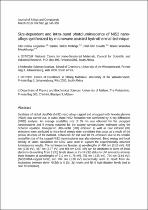 ResearchSpace
ResearchSpace
Size-dependent and intra-band photoluminescence of NiS2 nano-alloys synthesized by microwave assisted hydrothermal technique
JavaScript is disabled for your browser. Some features of this site may not work without it.
- ResearchSpace
- →
- Research Publications/Outputs
- →
- Journal Articles
- →
- View Item
| dc.contributor.author |
Linganiso, C

|
|
| dc.contributor.author |
Mhlanga, SD

|
|
| dc.contributor.author |
Coville, NJ

|
|
| dc.contributor.author |
Mwakikunga, Bonex W

|
|
| dc.date.accessioned | 2013-07-03T12:40:49Z | |
| dc.date.available | 2013-07-03T12:40:49Z | |
| dc.date.issued | 2013-03 | |
| dc.identifier.citation | Linganiso, C, Mhlanga, S.D, Coville, N.J and Mwakikunga, B.W. 2013. Size-dependent and intra-band photoluminescence of NiS2 nano-alloys synthesized by microwave assisted hydrothermal technique. Journal of Alloys and Compounds, vol. 552, pp 345-350 | en_US |
| dc.identifier.issn | 0925-8388 | |
| dc.identifier.uri | http://www.sciencedirect.com/science/article/pii/S0925838812018725 | |
| dc.identifier.uri | http://hdl.handle.net/10204/6869 | |
| dc.identifier.uri | https://doi.org/10.1016/j.jallcom.2012.10.102 | |
| dc.description | Copyright: 2013 Elsevier. This is an ABSTRACT ONLY. The definitive version is published in Journal of Alloys and Compounds, vol. 552, pp 345-350 | en_US |
| dc.description.abstract | Synthesis of nickel disulfide (NiS2) nano-alloys capped and uncapped with hexadecylamine (HDA) was carried out. A cubic phase NiS2 formation was confirmed by X-ray diffraction (XRD) analysis. An average crystallite size of 35 nm was obtained for the uncapped nanostructures and 9 nmwas obtained for the capped nanostructures estimated using the Scherrer equation. Unexpected ultra-violet (UV) emission as well as near infrared (IR) emissions were attributed to intra-band energy state transitions that occur as a result of the porous structure of the material. Enhanced UV and near IR PL emissions due to the smaller crystallite size of the capped NiS2 nanostructures was also observed. Band energy and local density of states calculation for NiS2 were used to support the experimentally observed luminescence results. The luminescence features at wavelengths of 400 nm (3.10 eV), 428 nm (2.90 eV), 447 nm (2.77 eV) and 464 nm (2.67 eV) can be attributed to some of those electrons de-exciting from S (3p) levels down to the Ni (3d) (blue to UV emission) whereas those features at wavelengths of 710 nm (1.75 eV), 751 nm (1.65 eV), 754 nm (1.64 eV), [NiS2/HDA-capped NiS2] and 784 nm (1.58 eV) respectively seem to result from de-excitations between either Ni(3d) or S (3s, 3p) levels and Ni–S hybridization levels (red to near IR emission). | en_US |
| dc.language.iso | en | en_US |
| dc.publisher | Elsevier | en_US |
| dc.relation.ispartofseries | Workflow;11160 | |
| dc.subject | Nickel disulfide | en_US |
| dc.subject | Microwave | en_US |
| dc.subject | Photoluminescence | en_US |
| dc.subject | Band structure | en_US |
| dc.subject | Density of states | en_US |
| dc.title | Size-dependent and intra-band photoluminescence of NiS2 nano-alloys synthesized by microwave assisted hydrothermal technique | en_US |
| dc.type | Article | en_US |
| dc.identifier.apacitation | Linganiso, C., Mhlanga, S., Coville, N., & Mwakikunga, B. W. (2013). Size-dependent and intra-band photoluminescence of NiS2 nano-alloys synthesized by microwave assisted hydrothermal technique. http://hdl.handle.net/10204/6869 | en_ZA |
| dc.identifier.chicagocitation | Linganiso, C, SD Mhlanga, NJ Coville, and Bonex W Mwakikunga "Size-dependent and intra-band photoluminescence of NiS2 nano-alloys synthesized by microwave assisted hydrothermal technique." (2013) http://hdl.handle.net/10204/6869 | en_ZA |
| dc.identifier.vancouvercitation | Linganiso C, Mhlanga S, Coville N, Mwakikunga BW. Size-dependent and intra-band photoluminescence of NiS2 nano-alloys synthesized by microwave assisted hydrothermal technique. 2013; http://hdl.handle.net/10204/6869. | en_ZA |
| dc.identifier.ris | TY - Article AU - Linganiso, C AU - Mhlanga, SD AU - Coville, NJ AU - Mwakikunga, Bonex W AB - Synthesis of nickel disulfide (NiS2) nano-alloys capped and uncapped with hexadecylamine (HDA) was carried out. A cubic phase NiS2 formation was confirmed by X-ray diffraction (XRD) analysis. An average crystallite size of 35 nm was obtained for the uncapped nanostructures and 9 nmwas obtained for the capped nanostructures estimated using the Scherrer equation. Unexpected ultra-violet (UV) emission as well as near infrared (IR) emissions were attributed to intra-band energy state transitions that occur as a result of the porous structure of the material. Enhanced UV and near IR PL emissions due to the smaller crystallite size of the capped NiS2 nanostructures was also observed. Band energy and local density of states calculation for NiS2 were used to support the experimentally observed luminescence results. The luminescence features at wavelengths of 400 nm (3.10 eV), 428 nm (2.90 eV), 447 nm (2.77 eV) and 464 nm (2.67 eV) can be attributed to some of those electrons de-exciting from S (3p) levels down to the Ni (3d) (blue to UV emission) whereas those features at wavelengths of 710 nm (1.75 eV), 751 nm (1.65 eV), 754 nm (1.64 eV), [NiS2/HDA-capped NiS2] and 784 nm (1.58 eV) respectively seem to result from de-excitations between either Ni(3d) or S (3s, 3p) levels and Ni–S hybridization levels (red to near IR emission). DA - 2013-03 DB - ResearchSpace DP - CSIR KW - Nickel disulfide KW - Microwave KW - Photoluminescence KW - Band structure KW - Density of states LK - https://researchspace.csir.co.za PY - 2013 SM - 0925-8388 T1 - Size-dependent and intra-band photoluminescence of NiS2 nano-alloys synthesized by microwave assisted hydrothermal technique TI - Size-dependent and intra-band photoluminescence of NiS2 nano-alloys synthesized by microwave assisted hydrothermal technique UR - http://hdl.handle.net/10204/6869 ER - | en_ZA |





